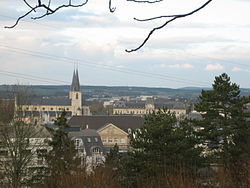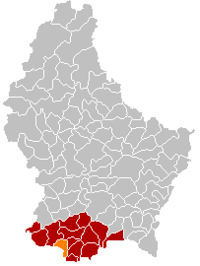Esch-Alzette
|
Esch-sur-Alzette Esch-Uelzecht |
||
|---|---|---|
| Commune | ||

The town seen from the Gaalgebierg parc
|
||
|
||
 Map of Luxembourg with Esch-sur-Alzette highlighted in orange, and the canton in dark red |
||
| Coordinates: 49°29′49″N 5°58′50″E / 49.4969°N 5.9806°ECoordinates: 49°29′49″N 5°58′50″E / 49.4969°N 5.9806°E | ||
| Country |
|
|
| Canton | Esch-sur-Alzette | |
| Government | ||
| • Mayor | Vera Spautz | |
| Area | ||
| • Total | 14.35 km2 (5.54 sq mi) | |
| Area rank | 84 of 105 | |
| Highest elevation | 426 m (1,398 ft) | |
| • Rank | 32nd of 105 | |
| Lowest elevation | 279 m (915 ft) | |
| • Rank | 87th of 105 | |
| Population (2014) | ||
| • Total | 32,600 | |
| • Rank | 2nd of 105 | |
| • Density | 2,300/km2 (5,900/sq mi) | |
| • Density rank | 1st of 105 | |
| Time zone | CET (UTC+1) | |
| • Summer (DST) | CEST (UTC+2) | |
| LAU 2 | LU00010004 | |
| Website | esch.lu | |
Esch-sur-Alzette (Luxembourgish: Esch-Uelzecht pronounced [ˈæʃ ˈuə̯lt͡səɕt], German: Esch-an-der-Alzette or Esch-an-der-Alzig, French: Esch-sur-Alzette) is a commune with town status in south-western Luxembourg. It is the country's second "city", and its second-most populous commune, with a population of 33,286 inhabitants. It lies in the south-west of the country, on the border with France and in the valley of the Alzette, which flows through the town. The town is usually referred to as just Esch; however, the full name distinguishes it from the village and commune of Esch-sur-Sûre which lies 45 kilometres (28 miles) further north. The country's capital, Luxembourg city, is roughly 15 km (9.3 mi) to the north-east.
For a long time Esch was a small farming village in the valley of the Uelzecht river. This changed when important amounts of iron ore were found in the area in the 1850s. With the development of the mines and the steel industry the town's population multiplied tenfold in a couple of decades. In 1911 the steel and iron producing company ARBED was founded. and the development of the steel industry, especially in the south of the country, provided Luxembourg with sustained economic growth during the second half of the 19th century.
In the 1970s as a result of the steel crisis the mines and many of the blast furnaces were shut down, the last one, in Esch-Belval, definitely halting its operations in 1997. The blast furnaces were replaced by an electric furnace that is fed with scrap metal rather than iron ore.
...
Wikipedia

